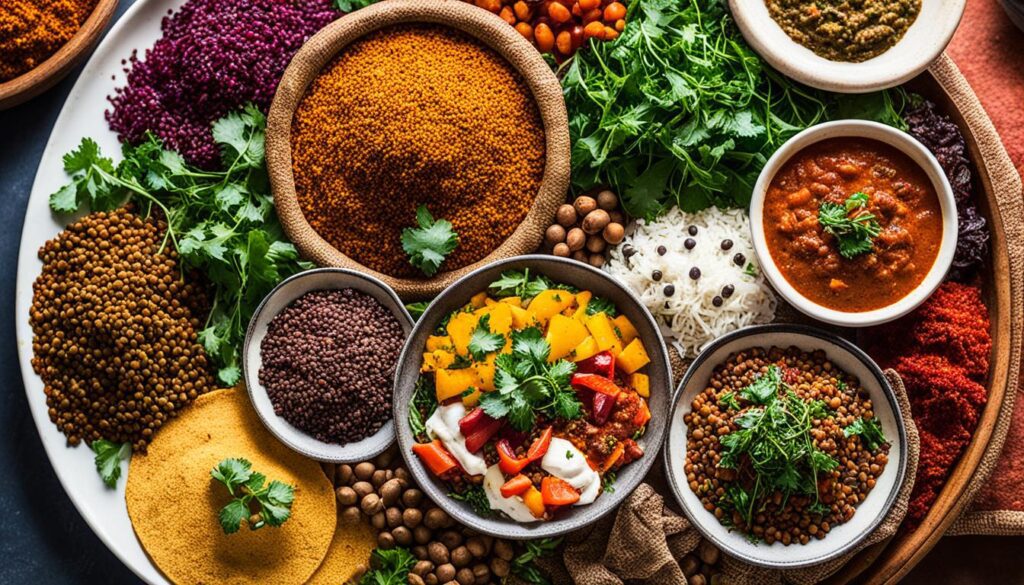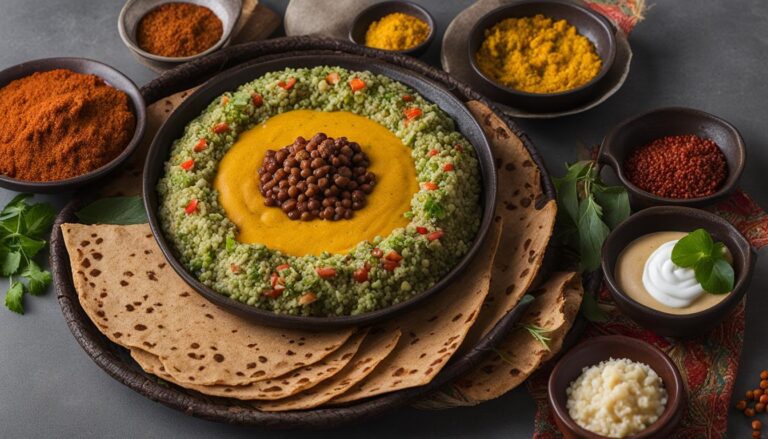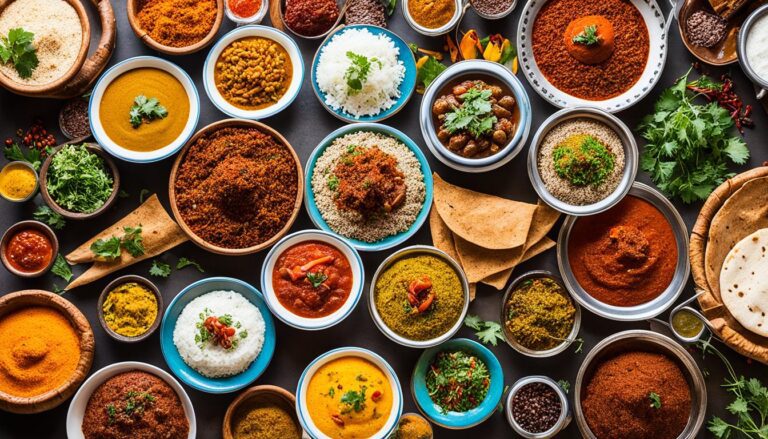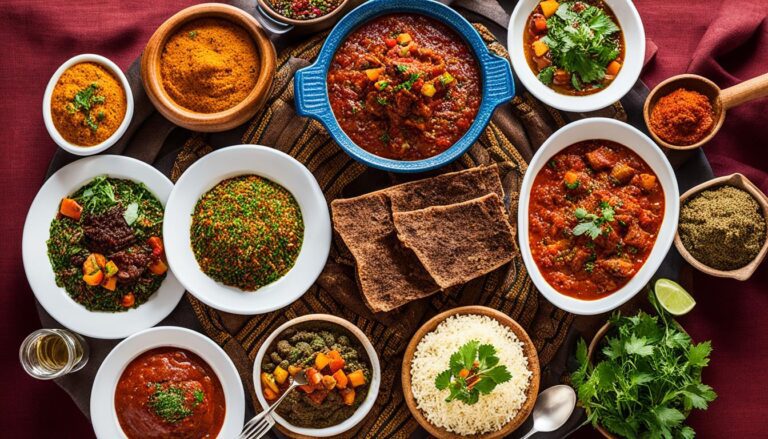Where Does Ethiopian Food Come From?
Have you ever wondered about the origins of Ethiopian cuisine? What makes it so unique and flavorful? Let’s take a culinary journey and explore the fascinating history and diverse flavors of Ethiopian food.
Key Takeaways:
- Ethiopian cuisine is a blend of introduced spices and ingredients with indigenous grains.
- The base seasoning used in many Ethiopian dishes is called Berbere.
- Injera, a sour fermented teff flour bread, is a staple in Ethiopian dining.
- Ethiopian cuisine is known for its communal sharing of meals and warm hospitality.
- The Ethiopian coffee ceremony is an essential part of Ethiopian culture.
A Taste of Ethiopian Cuisine: Flavors and Spices
The profile of Ethiopian food is characterized by its distinct flavors. It combines earthy, spicy, tart, sour, and pungent tastes. The base seasoning used in many Ethiopian dishes is Berbere, a blend of spices that typically includes chile peppers, fenugreek, cinnamon, ginger, cardamom, and coriander.
Berbere adds a spicy kick and depth of flavor to Ethiopian cuisine. Other common spices used in Ethiopian cooking are ajwain, radhuni, korarima, nigella, and fenugreek. These spices are used in combination with chilis and salt to create flavorful dishes. The use of spices and seasonings is an essential aspect of Ethiopian cuisine and contributes to its unique taste profile.
In every Ethiopian dish, the combination of these flavors and spices creates a harmonious mixture that delights the taste buds. Whether you’re savoring the heat of chile peppers, the warmth of cinnamon, or the aromatic essence of ginger, each bite of Ethiopian cuisine is a culinary adventure.
Ethiopian Dining Experience: Injera and Sharing Food
Ethiopian dining is a unique experience that immerses you in the vibrant food culture of Ethiopia. One of the defining elements of Ethiopian cuisine is injera, a sour fermented teff flour bread that plays a central role in every meal.
Traditional injera, a key component of Ethiopian dining
Injera serves as both a plate and utensil, adding a distinct flavor and texture to every bite. When dining Ethiopian style, dishes are typically served on top of a large communal plate called a t’ree. The injera-lined plate symbolizes the borderless nature of Ethiopian cuisine and reflects the culture of sharing food.
When enjoying an Ethiopian meal, you are encouraged to eat with your hands, tearing off a piece of injera and using it to scoop up a bite-size portion of food. This tactile experience creates a connection with the food and stimulates the senses, allowing you to fully appreciate the flavors and textures of each dish.
Sharing food is an integral part of Ethiopian food culture, embodying the country’s hospitality and sense of community. Sitting around a shared plate and passing it among friends and family fosters a warm and convivial atmosphere. Ethiopian dining is not just about satisfying hunger; it’s about coming together, building relationships, and celebrating the joy of food.
Traditional Ethiopian Dishes You Need to Try

Ethiopian cuisine is renowned for its diverse range of traditional dishes that highlight the unique flavors and ingredients of the country. There are several must-try dishes that capture the essence of Ethiopian cuisine. One such dish is tibs, a flavorful beef dish sautéed with onions, garlic, and the signature Berbere seasoning. Served with injera, a sour fermented bread, tibs is a delicious and satisfying meal that showcases the bold flavors of Ethiopian food.
Another popular traditional dish is shiro be kibbe, a legume or lentil stew with a rich, red sauce. Made with ground split peas, chickpeas, and spiced butter, shiro be kibbe offers a hearty and comforting eating experience. The combination of spices and seasonings creates a harmonious blend of flavors that is sure to leave a lasting impression.
For the more adventurous food lovers, kitfo is a must-try dish. Kitfo is Ethiopian beef tartare, made with ground raw beef mixed with spiced butter. This unique dish is packed with bold flavors and textures, providing a truly immersive culinary experience.
These traditional Ethiopian dishes are just a glimpse into the rich and flavorful cuisine of Ethiopia. From tibs to shiro be kibbe and kitfo, exploring traditional Ethiopian recipes is a delightful way to experience the country’s culinary heritage.
The Ethiopian Coffee Ceremony

The Ethiopian coffee ceremony is a cultural tradition that showcases the rich coffee culture of Ethiopia. It is a delightful experience for visitors, offering a unique insight into the traditional preparation and enjoyment of coffee in Ethiopian society.
The ceremony starts with the roasting of green coffee beans over an open flame. The aroma of the beans fills the air, creating an inviting atmosphere. Once the beans are roasted to perfection, they are ground manually using a mortar and pestle, preserving their flavors and aromas.
The freshly ground coffee is then brewed in a traditional clay pot called a jebena. This distinctive brewing method further enhances the flavors of the coffee, resulting in a delicious and aromatic beverage.
The coffee is served in small, granite cups known as cini, which add a touch of elegance to the ceremony. Friends, family, or guests gather around to enjoy this special moment together, engaging in meaningful conversations and savoring the rich flavors of the coffee.
The Ethiopian coffee produced during the ceremony is known for its distinct taste and quality. It is often served with traditional snacks like popcorn or roasted barley, enhancing the overall experience.
The coffee ceremony holds significant cultural value in Ethiopia, symbolizing hospitality, friendship, and community. It is a time for people to come together and connect, sharing stories and forging deeper connections.
The Ethiopian coffee ceremony is not just about the coffee itself; it is a representation of the warmth and inclusiveness of Ethiopian culture. It is an experience that should not be missed for anyone seeking a deeper understanding of Ethiopian traditions and the country’s love affair with coffee.
Conclusion
Ethiopian cuisine offers a rich and diverse culinary experience that combines introduced spices and ingredients with indigenous grains and proteins. The distinct flavors and tastes of Ethiopian food, characterized by their spiciness, tartness, and pungency, have made Ethiopian cuisine popular internationally.
Ethiopian dining is not just about the food; it is a cultural experience that revolves around the communal sharing of meals and the warm hospitality that accompanies it. From savoring the tangy injera to indulging in traditional dishes like tibs and kitfo, every bite is a journey into the country’s culinary heritage and cultural traditions.
And let’s not forget the unique Ethiopian coffee ceremony, a cherished tradition that brings people together over a cup of rich, aromatic coffee. Exploring Ethiopian cuisine is an opportunity to immerse oneself in the vibrant flavors and the warm spirit of Ethiopian food culture. So, whether you’re trying Ethiopian food for the first time or already a fan, be prepared to embark on a flavorful adventure that will not only satisfy your taste buds but also provide a window into the heart and soul of Ethiopia.







